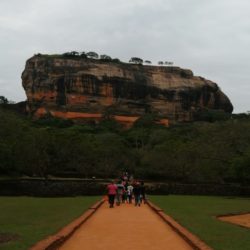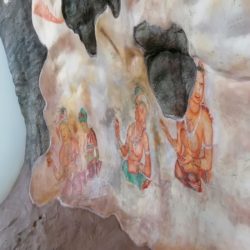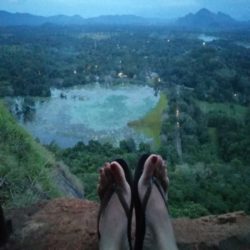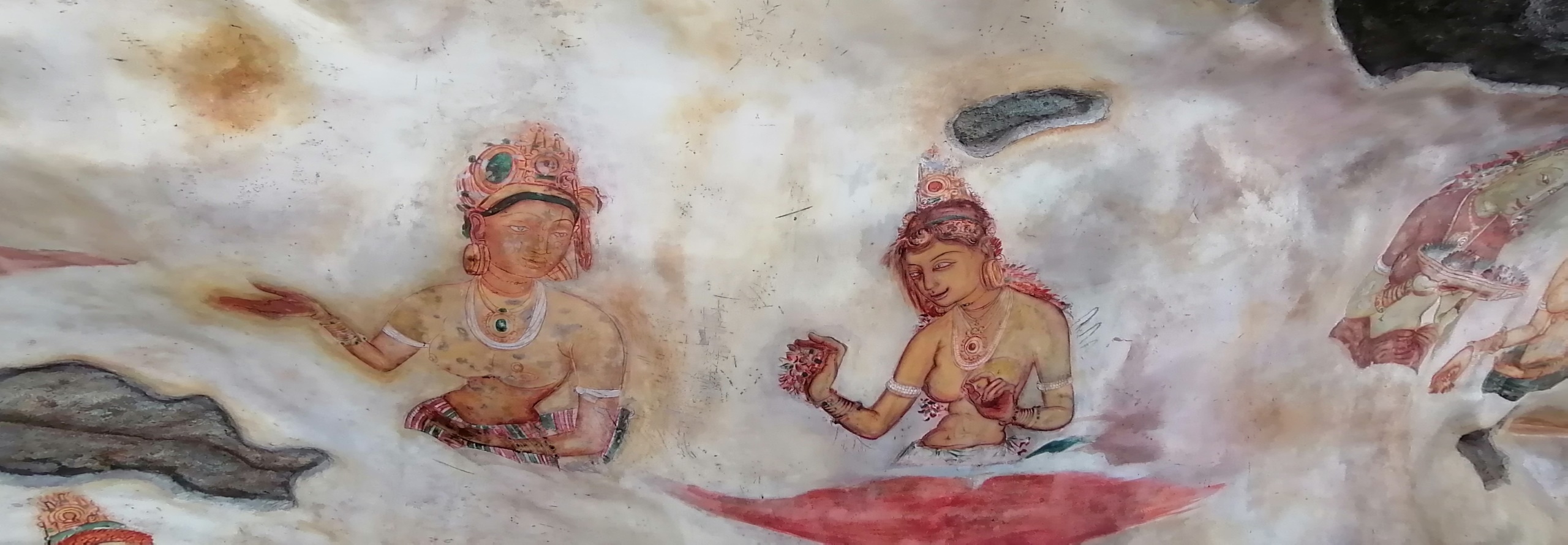Helloli: The Forgotten Daughters of Kuveni
Meghali stared at the majestic rock edifice looming as she walked towards it in the late afternoon sunlight. The Lion’s Neck or ‘Sinha Giriya’, now Sigiriya, a UNESCO world heritage site with a written history of 1500 years and an unsolved mystery on its western rock face, had captured the imagination of colonisers, scholars, poets and laymen for centuries.
On either side of the path were the ponds and the fountains that made up the famous water gardens which beheld amphora, jewels and coins from its time of Roman trade in the 5th century AD. Meghali’s silhouette was framed on the reddish brown earth as she walked towards the rock that held for her a fascination since she was a child.

Many were the stories of the legendary Sigiriya. Famed rock fortress, leisure palace and supposed hiding place of the patricide King Kassapa; Apparent monastery before Kassapa’s time and supposedly one of Mahayana faith. But more than anything was the fascination of those women portrayed on the western rock face; Almost looking out to those who dared ascend those steps and beheld their beauty behind the mirrored wall.
Meghali remembered her mother telling her “Those women are topless. But that is our heritage. The women of this country proudly bared their breasts before Victorian colonisation made us ashamed of our own.”
As Meghali walked up the stone steps through the rocks and up the side which would lead her to the viewing gallery of the paintings, she stared in fascination at the yellow mirror wall that was said to have glistened like a mirror in its day. The yellow still shone, rather pale now, almost as if in resignation of its fate – to be subjected to fungal infections. Yet before that, it became the tapestry of poets visiting Sigiriya. She noticed the barely visible graffiti scrawled on the wall, said to be written in old Sinhalese, 200 years after the fall of Kassapa.
As she walked along the wall, she could feel the strong winds blowing and pulling at her shawl but the wall protected her from the force of the gusts and the shawl remained across her bosom and shoulders.
Meghali was travelling alone because she had decided to explore the country she called her home while global travel restrictions were in place, and while she figured out her true raison d’être as a 30 something year old. Sigiriya was a favourite but she felt she had not truly grasped what it had to offer. Those frescoes in particular drew her fancy and what she learned in school was not enough to explain what Sigiriya truly represented.
The paintings of the women were located in a gallery that was a niche in the rock face halfway up and the access was by a long path and a wrought iron spiral staircase that rose behind the mirror wall. Meghali looked up eagerly. The spiral staircase was encased with a black mesh like a canon pointed upwards and she walked upto it quickly and ascended the steps to the viewing gallery.
Today there was hardly anybody. Covid and a combination of travel restrictions had ensured that Sigiriya remained relatively empty. And so Meghali found herself alone at the viewing gallery. She smiled in awe as she took in the different images painted. Women in hues of golden yellow and touches of red, painted in different poses – some holding kapuru flowers, some holding trays of flowers, lotuses, others indicating to each other almost in conversation. Each had elegantly adorned hairstyles with jewelled ornamentation. Most had large elliptical earrings and many wore chains with a padakkam in the centre. Noticeable amongst all was the distinct shape of their bare breasts though some were said to be wearing a flimsy shawl of exquisite weaving. Meghali smiled as she took in the tiny waists they had with a slight protruding belly and flared hips. The women’s paintings ended at their hips. Their features were not Sri Lankan as per what we consider now – elongated eyes and almost aquiline noses. But they were beautiful. As Meghali stared at the images she felt the wind whistling almost the stories of these women and she found herself being transported to when Kassapa is said to have reigned over this magnificent edifice and commissioned these paintings.
An old woman appeared at the top of the spiral staircase and was looking at the paintings silently. She was in an orange and yellow woven cotton sari draped snugly around her body, with the fall tucked into her waist. Her hair was plaited – the flecks of grey peppered in between the strands. There were Jasmines placed in the indents of her plait which was halfway down her back. She had a weathered look but with a light in her eyes. Her face was covered in a cloth mask made of worn fabric. After a while she began speaking to Meghali.
“Daughter, do you know who these women are?”
Meghali responded,
“Yes, they are said to be either lightning or cloud damsels, Tara images or apsaras”.
The woman turned and said,
“Do you really think so?”
Meghali paused and looked at her. It was a strange question.
“Er yes, I think so. Or at least from what I have read.”
She smiled knowingly, slowly walked and stood opposite Meghali and said,
“Let me tell you daughter the story of our ancestors…”
“Over 1500 years ago, there reigned a king called Dathusena. He was a great king who built many things, and it is he who ended the South Indian control of Anuradhapura, our capital city at the time. South of Anuradhapura was the Malayarata which was ruled by a Viceroy. This Viceroy was usually the next in line to the throne. During the South Indian Pandyan rule of Anuradhapura, a young Dathusena was hidden in the Malayarata by his uncle, a Buddhist monk named Mahanama. And while here, Dathusena learned about the children of Kuveni – the Yaksha Queen of Lanka who was usurped by the invading Prince Vijaya – a wastrel from Bengal – over a 1000 years before. Kuveni’s children by Vijaya were hidden in the Malayarata and here they lived in secret, protected by the Yaksha tribe members who remained loyal to Kuveni.”
Meghali knew the story of Vijaya. People proudly claimed he was a Prince who was of Aaryan descent who ruled Lanka having usurped the Yaksha Queen Kuveni. Yaksha in modern parlance translates to demon. But that was not what it meant in her time. The Yaksha of yore were a tribe of great power. Kuveni was considered a woman of intelligence who was weaving cotton when Vijaya met her. She fell for his charm and was banished once he had taken over the country. Not forgetting the children he fathered with her.
“A typical male chauvinist and bloody ass” thought Meghali indignantly. Sri Lankans still fondly claimed Vijaya as their ancestor – the banished brat of Bengal – without realising that there was little to be admired in his actions.
The old lady continued her story.
“Dathusena met many people who were of Kuveni’s descent and he learned of their history and their story, which was not well known elsewhere due to the invading rulers and the subsequent kings who did not want another rightful heir laying claim to the throne. While in hiding, Dhathusena was disguised as a Buddhist monk and he happened upon a cult which worshipped Kuvera, the Hindu god and half brother to Ravana. The cult members were all women as they modelled themselves on Kuvera’s consort who was considered a Yaksha. This way they upheld Kuveni’s heritage as well.”
“Dhathusena was fascinated by this cult which had existed before Buddhism was introduced to Lanka. Among the followers, he was drawn to a beautiful woman who was of the Helloli indigenous caste. She was not of royal descent but she had a fire in her that Dhathusena was drawn to. Her understanding of the spiritual world was akin to the male scholars in the monasteries and she was acutely aware of her history and that of the people of Malayarata. She figured out who Dathusena really was and guided him in understanding the people and what he needed to be as king. Her name was Hela Devi but many do not know her by that name for her identity has been erased from written history.”
“Dhathusena eventually returned to Anuradhapura where he battled and took over the citadel from the Pandyans. He never forgot Hela Devi, for it was her that inspired him to be the man he had become. And so he took her as his consort and together they had his first son, Kassapa. As Anuradhapura prospered, Dhathusena did not forget Malayarata and built his most famous irrigation tank – the Kalavapi which is akin to an ocean – in the Malayarata. However as his reign progressed, Dhathusena was advised to take on a royal consort and have a ‘true’ heir to the kingdom. Hela Devi was not pleased but she took comfort in the knowledge that their son Kassapa would one day rule over this land that was rightfully his.”
Meghali recalled that Kassapa’s mother was considered a low caste concubine.
“Hela Devi, though not of royal descent, had her own ancestors and family who were loyal to her in the Malayarata. And so she introduced Kassapa to a famous rock monastery that was now abandoned and advised that he set up base there, since there were whisperings that his brother Moggallana was trying to be king. Hela Devi’s family would provide him protection, if required.”
“Kassapa cleared the wilderness that encased Sigiriya’s monastic ruins and he started building for himself a palace that would be suitable for a king. Kassapa was made the Viceroy of the Malayarata during this time and this enabled him to further develop Sigiriya.”
“His mother, Hela Devi, tutored Kassapa about his heritage, in the same way that she guided Dhathusena. A key point she kept reminding Kassapa of was that they were descendents of the true Queen of Lanka – Kuveni. She had been banished, punished and left to die by the usurper Vijaya. Her heritage must not be forgotten. And by virtue of Kassapa being the son of Dhathusena the King, and Hela Devi the descendent of Kuveni, Kassapa’s claim to the throne was greater than that of his brother whose mother was an Indian princess.”
“And so in remembrance of the Queen of Lanka, Kassapa decided to pay tribute to the women of his mother’s tribe – the Helloli – who were the descendants of Kuveni. He said, “I will dedicate Sigiriya to the Helloli and I will adorn the Western walls of the Sigiriya rock with their images as a reminder that they are the true daughters of Lanka”.
“Kassapa did this because he was also a great trader and had many ties with Greek, Roman and Persian traders who visited Lanka to trade in pearls, silks and spices. He would entertain these traders at Sigiriya and thereby, those traders would also learn of this history.”
“And so Kassapa commissioned the local artisans to paint the women of the Helloli tribe on the entire rock face. This was a bold move, for women were not seen as equals to men or powerful in their own right. The Helloli Kuvera Cult belied this belief but they were not of royal lineage as per the current royal line and so were not given any prominence; Till Kassapa came along. Kassapa had the paintings positioned on the rock face in such a way that the mirror wall would reflect these images during certain times of the day and thereby creating a multiplied effect of the images.”
“Kassapa painted his mother Hela Devi and his two daughters, Bodhi and Uppalavanna on the rock edifice. The images of the two daughters are now erased. But Hela Devi’s image, remains.”
Meghali was listening in awe to this story and exclaimed, “So these are the women of the Kuvera Cult?? Which one is Hela Devi??”
“Yes” Answered the old lady. “They are of the Helloli tribe. The descendents who are there even today”.
Meghali looked shocked and the old lady continued.
“Kassapa also introduced the practitioners of the Kuvera cult to Sigiriya. And they eventually became the chief incumbents of Sigiriya, led by Hela Devi. Sigiriya became the home of the Kuvera cult. And eventually Kassapa ascended the throne. The lineage of Kuveni had been restored.”
“But the Mahavamsa says that Sigiriya was a fortress and that Kassapa fled here for protection after killing his father” said Meghali, citing what was considered the gospel of Sri Lanka’s written history.
The old lady shook her head sadly.
“The Mahavamsa was written many centuries after this time and by then the story had sadly been warped. It is for those who read with their eyes closed. The story of Sigiriya is for those who can see with their hearts” she said.
“Moggallana, Kassapa’s brother, was jealous when Kassapa was made king and he fled to India to gather an army against his brother. During this time, Kassapa reigned a just king who looked after his people both in Anuradhapura and the Malayarata and ensured prosperity. The monks of the Mahavihara who practiced the Theravada tradition of Buddhism were not too pleased with his dabbling in the Kuvera cult, but they tolerated it because he gave the Mahavihara monks enough prominence and power.”
“Kassapa further strengthened the trade ties with the Greeks, Romans , Persians and Chinese. The land Silk route included a stopover in Lanka and so the famed Sigiriya paintings garnered fame both far and wide for Sigiriya became a place of leisure and entertainment for the visiting delegates.”
“When approaching Sigiriya from the Western gate, the women would look down on all those arriving, almost beckoning and almost daring them to approach. There are many stories that these women were escorts to men but it is not in the context that we understand it today. They were escorts to introduce men to a spiritual awakening. There is no shame there.”
“18 years after Kassapa became king, Moggallana returned with an Indian army and slew his brother in Anuradhapura. Thereafter Moggallana did all in his power to erase the identity of his brother as a just king. And so he propagated the story among the Buddhist monks that Kassapa had killed their father Dhathusena in exchange for the wealth of the kingdom. An elaborate story was woven about how he cemented his father in concrete because the father, Dhathusena, showed Kassapa the Kalavapi when asked for his greatest wealth. Hence Kassapa was cast as a patricide king and this myth lives on to this day.”
A sudden noise reached their ears as a group of chattering and whistling boys passed the mirror wall down and out of sight. It was jarring – there were signs saying to remain silent in case the hornets of Sigiriya were disturbed. They clearly did not adhere to these warnings.
“But still, the fruits of his labour and the women he chose to honour, live on. Sigiriya was sheltered in the wilderness for almost 1000 years till the suddhas (white men) re-discovered it. And even then, no one has been able to explain who these women are. Because they all believe the written word. History is never one story, my daughter. And it is sadly interpreted in a very narrow way.”
Meghali listened in awe to the old lady. The wind was picking up speed and it was whistling all around them but it was a warm wind.
“You mentioned the Helloli live on to this day. Where are they and why don’t we know about them??” Meghali asked in wonder.
The old lady smiled. “Come visit the villages around us. We are the daughters of Lanka, the descendents of Kuveni, the practitioners of Kuvera’s cult and the minstrels of this story. You will not find us in the history books – those are written by men. Not the men of our villages or of our time – but men influenced by what they have seen from the suddhas. Influenced to a point where they are unable to understand the beauty of a woman’s body and thereby condemn us to cover ourselves in shame when the shame is not ours, it is theirs.”
“Which of these women is Hela Devi?” Meghali asked while staring at the paintings.
The old lady said, “Which one do you think?”
As Meghali was contemplating on which of the women could be Hela Devi, a sudden strong gust of wind blew against them and rattled the spiral staircase. In that instant, Meghali’s shawl was lifted off her shoulders and was blown away with the wind over the mirror wall and down below.
The old woman smiled knowingly. “Our ancestors are passing you a message daughter. Be proud of who you are. Don’t cover yourself, for the shame is not in the bearer but in the beholder who cannot see, who cannot feel and who cannot be as nature intended us to be. Be proud of who you are. You are a daughter of this land. Be proud.”
With these words the old woman slowly removed her mask, smiled, bowed slightly, tossed some grains of rice up at the paintings, turned around and slowly made her way down the stairs to the level below and disappeared from view. Meghali stared after her, at a loss for words. She had forgotten to ask the old lady her name. How was she to find her again? And ask her about the fantastic story she had just told her?
And which one was Hela Devi??
Meghali glanced at the nearest painting of the woman which seemed to be beckoning to her with a knowing smile. The woman’s head was half erased and her hand was outstretched towards the Pidurangala rock which was surrounded by many little villages even today. It was an invitation to partake in the history of Lanka from the eyes of a woman and the mouths of those silenced over the years.

Meghali stood on the platform looking out in wonder at everything around Sigiriya – the lakes, the forests, the stupas and the beautiful gardens. She remembered her shawl but did not bother to go look for it. Instead she went down to the mirror wall and looked at some of the roughly scrawled poetry written by the visitors of yore.
“Hail! I am Vira-Vidur-bata. I wrote this.
The gentle breeze blew – the breeze which is wet with cool dew drops – taking with it fragrant perfume; in the spring sunshine, the jasmine and the water lily, being adorned with flowers, shone all over. Leaving it all aside, my mind was agitated on seeing these golden-coloured ones and, being shot at, whilst going, by their side-long glances, I became prostrate on the slope of this rock.
Having seen to my heart’s content, the five hundred damsels on the surface of the rock, and having well remembered one of them, Heaven itself does not take my mind”[1].
Like Kassapa, like the men who wrote this poetry, Meghali could feel herself being drawn to these women who had remained true to their nature for 1500 years on the face of a rock defaced by man’s narrow interpretation and understanding of themselves and of their own history.
Meghali quickly ran along the mirror wall, ran up the steps and came to the great lion’s paws that led to the final ascent to the summit. The lion’s head had never been seen in living history. And she suddenly wondered if it had been a lion or a lioness? What animals did the Kuvera cult venerate? Was it even a lion??
Meghali went up the steps and carefully climbed the final precarious stairs to the top. The winds were blowing and the dust billowed in little clouds. She ran along the top and suddenly let out a shriek of delight. It travelled with the wind and scattered into the ears of a few groups of people who glanced back but went back to their own viewings, selfies and strolling.
The summit of Sigiriya was vast and the foundations of many buildings were still visible. There were many bathing ponds with green water and several ledges, stairs, dips and sudden freshly dug holes. The trees along the edge and in some of the places offered little shelter from the glare of the setting sun and the howling wind. But it was beautiful in its raw nakedness. No souvenir shops up here. No lights. Nothing. Just the bare bones of a once beautiful creation which Meghali just learned had been the home of a cult of learned women.

What a story. Could it be true? She wondered as she walked along the steps to the furthest corner where there is said to have been a niche cut into the rock which served as a guard room in ancient times. Meghali gingerly walked along the edge and sat inside the niche. It looked out at the vista below and she could see the pin drops of light of vehicles moving like ants along the roads, the bright white of the stupas, the lakes with lotuses and as she looked up at the evening sky, she noticed Venus. The evening star had risen to greet her as she gazed in wonder and listened to the whispers as they howled with the wind.
Sing your song O daughter of this land
Be proud of what you behold, be unafraid to stand
Our story is for those who can see from their souls
For history is often a tale of many black holes
These words just came into Meghali’s thoughts as she sat there and it was like someone had switched on a light in her head. Gone were the cobwebs that had been clouding her mind these past few years. Gone was the misery she had left behind when she had chosen to walk out rather than endure.
“A woman’s place is in the home.”
No.
A woman’s place was where she was home. Right now, atop a rock.
The mud had been slung far and wide but Meghali had borne it all. And she would continue to do so.
Like the forgotten daughters of Kuveni, she would regain what was lost. What was rightfully hers.
It was time to set the record straight.
[1] Translated by S. Paranavitane, 1956.









